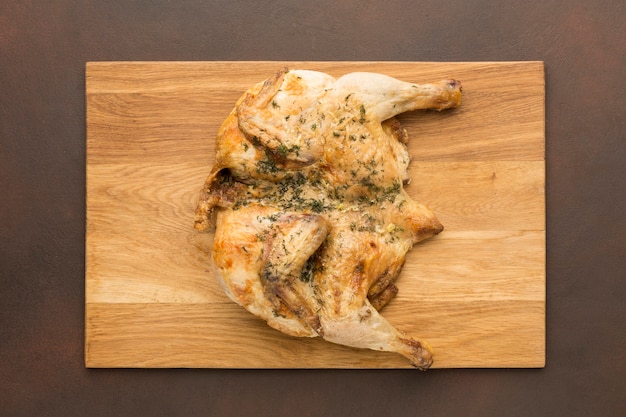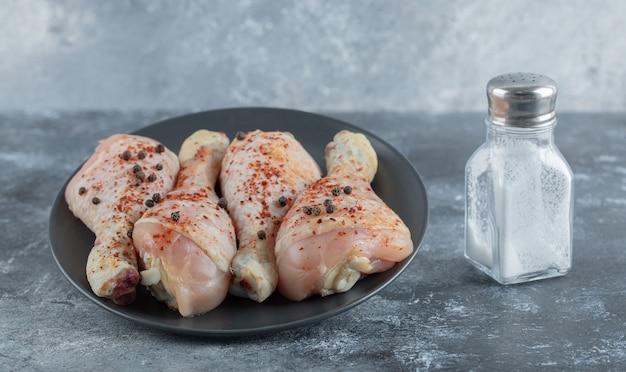We've all been there: staring at that frozen chicken in the freezer, craving a delicious roast dinner but realizing we've left it a little too late to defrost. "Can I even cook it from frozen?" you might wonder. Fear not, my fellow foodie! It's absolutely possible to cook frozen chicken, but there are some crucial safety points to remember. This article is your comprehensive guide to navigating the world of frozen chicken, ensuring you enjoy a delicious meal without any food poisoning worries.
(Part 1) Why Frozen Chicken Requires Special Attention

Let's start by understanding why frozen chicken presents a slightly different challenge compared to fresh. It's all about temperature and those pesky little bacteria. You see, bacteria love to hang out in frozen food, but they don't multiply significantly when temperatures are below freezing. The real trouble starts when you begin thawing. As the chicken warms up, those bacteria get excited and start multiplying like crazy! This is where the risk of food poisoning comes in, if you're not careful.
Time is the Enemy
The longer your frozen chicken sits around thawing, the more time those bacteria have to party and potentially make you unwell. That's why it's absolutely critical to cook frozen chicken thoroughly, ensuring it reaches a safe internal temperature to zap those microbes. I always tell my family, "Think of it like a race against time!"
(Part 2) The Golden Rule: Cook From Frozen

Now, let's get practical. How do you cook frozen chicken safely? The most important rule to remember is: cook it straight from frozen, don't even think about thawing it first. Why? Because it dramatically reduces the time bacteria have to multiply.
Temperature and Time: Your Cooking Allies
Cooking frozen chicken requires a little more time than cooking fresh, to make sure that internal temperature reaches the safe zone. A trusty meat thermometer is your best friend here! You need to ensure that the internal temperature of the chicken hits at least 165°F (74°C).
Adjusting cooking time: A Quick Guide
The specific cooking time depends on the size and cut of the chicken, as well as the cooking method. Here's a handy guide:
- whole chicken: Increase the cooking time by about 50% compared to a fresh whole chicken.
- chicken breasts: Add around 25% extra cooking time.
- chicken thighs: Also add around 25% extra cooking time.
- chicken wings: Add about 15-20 minutes to the usual cooking time.
Remember, always check the specific cooking instructions on the frozen chicken packaging for the most accurate information. Safety first, always!
(Part 3) Cooking Methods: Your Options

Now, let's explore some common methods for cooking frozen chicken, all of which involve cooking from frozen:
1. Roasting: A Classic Choice
Roasting is a classic way to cook a whole chicken, and it works beautifully with frozen chicken. Just give it a bit more time than you would for a fresh chicken. I usually roast my frozen chicken for about 1 hour and 30 minutes to 2 hours, depending on the size.
Tips for Roasting Frozen Chicken:
- High Heat Start: Begin roasting at a high temperature, about 400°F (200°C) for the first 30 minutes. This helps the skin get nice and crispy.
- Lower Heat for Even Cooking: Then, reduce the oven temperature to 350°F (175°C) and continue cooking until the internal temperature reaches 165°F (74°C).
- Basting for Moisture: Baste the chicken with pan juices or butter during cooking to keep it moist and flavorful.
- Rest Time: Allow the chicken to rest for 10-15 minutes after cooking before carving. This lets the juices redistribute, resulting in a much juicier chicken.
2. Baking: Simple and Efficient
Baking is a great option for smaller cuts of frozen chicken, like breasts or thighs. It's a simple method that requires minimal fuss. Just place the chicken on a baking sheet lined with parchment paper and bake it in a preheated oven.
Tips for Baking Frozen Chicken:
- Preheating: Preheat your oven to 375°F (190°C).
- Cooking Time: The cooking time depends on the size and thickness of the chicken pieces. It typically takes about 45-60 minutes for frozen chicken breasts to cook through.
- Temperature Check: Always use a meat thermometer to ensure the internal temperature reaches 165°F (74°C).
- Moisture: To prevent the chicken from drying out, add a bit of water or broth to the bottom of the baking sheet.
3. Pan-Frying: A Quick and Easy Method
Pan-frying is a great way to cook smaller cuts of frozen chicken quickly. It does require a bit more attention to ensure even cooking, and you'll want to use a heavy pan that can hold heat well.
Tips for Pan-Frying Frozen Chicken:
- Heavy Pan: Use a heavy-bottomed pan that won't warp when heated.
- Heat: Heat the pan over medium-high heat.
- Oil: Add a good amount of oil to the pan.
- Chicken Placement: Place the chicken pieces in the pan, leaving some space between each one for even cooking.
- Cooking Time: Cook the chicken for about 6-8 minutes per side, or until it's golden brown and cooked through.
- Temperature Check: Use a meat thermometer to check the internal temperature. It should reach 165°F (74°C).
4. Grilling: A Smoky Delight
Grilling frozen chicken can be a fantastic way to enjoy that smoky grill flavor. Just make sure you're using a grill with a lid to help trap the heat and ensure even cooking.
Tips for Grilling Frozen Chicken:
- Preheating: Preheat your grill to medium-high heat.
- Chicken Placement: Place the frozen chicken on the grill, leaving a little space between each piece.
- Cooking Time: Cook for about 8-10 minutes per side, or until the chicken is cooked through.
- Temperature Check: Use a meat thermometer to check the internal temperature. It should reach 165°F (74°C).
- Keep it Covered: Keep the lid closed during cooking to trap the heat and ensure even cooking.
(Part 4) The Importance of Internal Temperature
It's important to remember that you can't always judge the doneness of chicken by its colour. That's why a meat thermometer is so crucial. It's the only way to be absolutely sure that your chicken is cooked through and safe to eat.
Using a Meat Thermometer: A Simple Guide
Insert the thermometer into the thickest part of the chicken, making sure it doesn't touch any bones. Leave it in for a few seconds to get an accurate reading. If the temperature is below 165°F (74°C), continue cooking until it reaches that safe temperature.
(Part 5) Dealing with Frozen Chicken Packaging
Those plastic bags and tough frozen chicken packs can be a bit of a pain, but there's a right way to handle them!
1. The No-Thawing Trick
If you're cooking straight from frozen, you can actually leave the chicken in its packaging. The packaging acts like a steamer, helping to cook the chicken evenly.
2. Removing Packaging: A Little Caution Needed
If your cooking method requires removing the packaging (like roasting or baking), go ahead, but be careful! Frozen chicken can be quite slippery and tricky to handle.
Tips for Removing Packaging:
- Thaw for a Few Minutes: If the packaging is too difficult to remove, thaw the chicken for a few minutes before trying to remove it.
- No Room Temperature Thawing: Never thaw chicken at room temperature. This is a breeding ground for bacteria.
(Part 6) Safety First: Avoiding Food Poisoning
Cooking frozen chicken safely isn't just about the cooking process. Here are some essential safety tips to keep in mind:
1. Cleanliness is Key!
Wash your hands thoroughly with soap and water before and after handling raw chicken. Also, clean and disinfect all surfaces that have come into contact with raw chicken, including cutting boards, utensils, and countertops.
2. Separate It!
Keep raw chicken separate from other foods, especially ready-to-eat foods like salads or fruits. Use separate cutting boards and utensils for raw chicken to avoid cross-contamination.
3. Cook It Thoroughly: The Golden Rule
We've covered this before, but it's worth repeating: Cook frozen chicken to an internal temperature of at least 165°F (74°C). Don't take any chances with undercooked chicken.
4. Chill It Down!
Refrigerate cooked chicken promptly. It should be stored in the fridge for up to 3-4 days, but ideally, aim to eat it within a couple of days for the best flavour and texture.
5. Reheating Rules: Get It Hot!
When reheating cooked chicken, make sure it's heated through to at least 165°F (74°C). Avoid reheating it more than once.
(Part 7) Frozen Chicken: A Convenient Choice
Let's be honest, frozen chicken is a lifesaver! It's affordable, convenient, and always there when you need a quick and easy meal solution.
Why I Love Frozen Chicken
I love having frozen chicken in my freezer! It's great for those nights when I need a meal in a hurry, and I love that it has a long shelf life. I've got a whole frozen chicken in my freezer right now that's been there for weeks, just waiting for its turn to be cooked.
(Part 8) Understanding food safety Labels
You'll often see labels on frozen chicken packages that can seem a bit confusing, but they're there to help you!
"Sell By" Date: A Store Guideline
This date tells the store how long they can keep the chicken on their shelves. It's not a safety guideline, and frozen chicken can still be safe to eat after this date.
"Use By" Date: Quality Indicator
This date indicates when the quality of the chicken starts to decline, but it's not a safety date. I always try to use the chicken before this date to ensure the best flavour and texture.
"Frozen On" Date: Tracking Storage
This date tells you when the chicken was frozen, which can help you determine how long it has been in the freezer.
(Part 9) Frozen Chicken Myths Debunked
Let's tackle some common myths about frozen chicken.
1. Myth: Frozen Chicken is Less Nutritious
Frozen chicken can be just as nutritious as fresh chicken. The freezing process doesn't significantly impact its nutritional value.
2. Myth: Frozen Chicken is Tasteless
Frozen chicken can be just as flavorful as fresh chicken. Choose a good quality brand and cook it properly, and you'll be happy with the results.
3. Myth: You Can Only Cook Frozen Chicken Once
You can cook frozen chicken as many times as you like. Just make sure it's cooked to a safe internal temperature each time.
(Part 10) FAQs: Your Frozen Chicken Questions Answered
1. Can I defrost frozen chicken in the microwave?
While convenient, it's not recommended to defrost chicken in the microwave because it can cook unevenly, creating areas where bacteria can still thrive.
2. Can I cook frozen chicken in a slow cooker?
You can cook frozen chicken in a slow cooker, but it's not the ideal method because it can take a very long time to cook through, increasing the risk of bacteria growth.
3. Can I eat frozen chicken that has been thawed and refrozen?
It's not recommended to refreeze thawed chicken. Thawing and refreezing can lead to bacteria growth, so it's best to cook it immediately after thawing.
4. What if I accidentally cook frozen chicken for too long?
If you cook frozen chicken for too long, it can become dry and tough. It's not necessarily unsafe to eat, but it won't be very pleasant.
5. How can I tell if frozen chicken is bad?
If the chicken has an off odour or an unusual colour (like grey or green), it's best to throw it out.
Armed with this knowledge, you can now confidently cook frozen chicken with safety and confidence. Enjoy your delicious meals!
Everyone is watching

Corn on the Cob: The Ultimate Guide to Perfectly Cooked Ears
Healthy MealsAh, corn on the cob. Just the name evokes images of sunny days, barbecues, and that sweet, juicy flavour that ...

Perfect Pork Roast Oven Cooking Time: A Guide to Delicious Results
Healthy MealsThere's something truly satisfying about a perfectly roasted pork. The aroma alone is enough to make your mout...

Ham Cooking Time: How Long to Bake, Smoke, or Boil a Delicious Ham
Healthy MealsAh, ham. It's a classic, isn't it? A real crowd-pleaser, especially around holidays. And when done right, it'...

Scallops: The Ultimate Guide to Perfect Cooking
Healthy MealsAh, scallops. Those delicate, sweet, and utterly delicious morsels of the sea. They hold a special place in my...

Spaghetti Squash: The Ultimate Guide to Cooking and Serving
Healthy MealsRemember that time you saw spaghetti squash at the supermarket, looking all bumpy and strange, and thought, "W...
